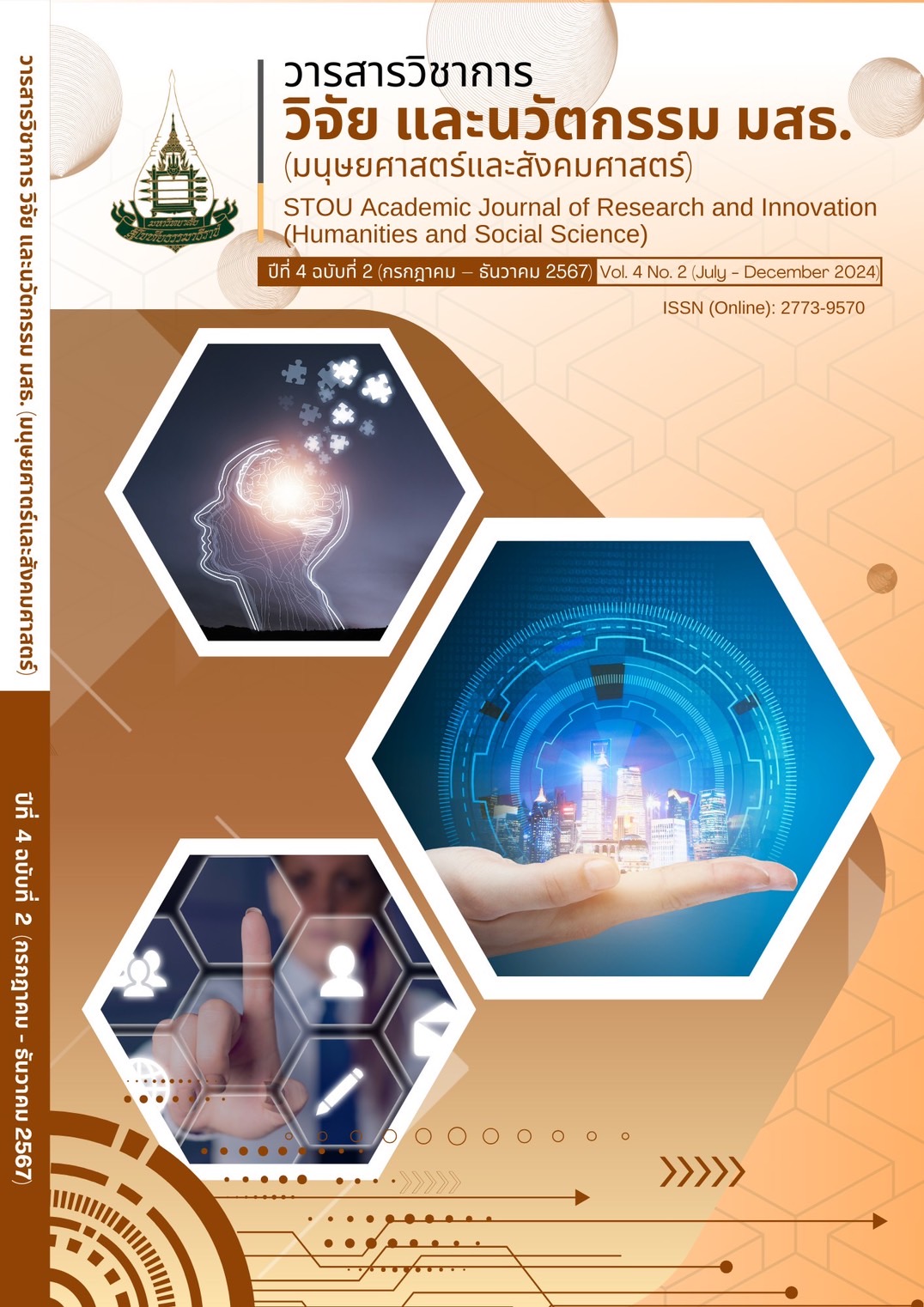Path Analysis of the Influence of Competency, Fairness, People-Centeredness, and Service-Mindedness on Value Driven Behavior in the Royal Thai Police Force
Keywords:
Competency, Fairness, People-Centeredness, Service-Mindedness, ValueAbstract
This quantitative research aims to analyze the influence of competency, fairness, people centeredness, and service-mindedness on the value-driven behavior of police trainees, using path analysis to examine the causal relationships between variables. The sample consisted of 201 police trainees selected from the training program for the fiscal year 2023, with data collected from December 2023 to March 2024. The research instrument was a three-part questionnaire, including demographic information and Likert scale questions on the main variables. A pilot study was conducted with 20 participants to test the instrument, resulting in content validity (IOC) scores above 0.70, a Cronbach's Alpha of 0.87, and acceptable construct validity (CFA), with CFI = 0.76 and RMSEA = 0.06 Data were analyzed using descriptive statistics and path analysis.
The findings showed that R² = 0.347, indicating that 34.7% of the variance in police trainees' value-driven behavior (VALUE) could be explained by the variables in the model. Competency (COMPE) had a direct influence on VALUE, with a coefficient of 0.818, demonstrating that higher competency leads to stronger adherence to values. Fairness (OFAIR) had a direct influence on VALUE, with a coefficient of 0.776, indicating that a fair and just system enhances trainees' value-driven behavior. Additionally, People-centeredness (PEOPL) had an indirect influence on VALUE through OFAIR, with a coefficient of 0.597, showing that emphasizing people-centeredness promotes fairness and justice, which in turn strengthens value-driven behavior. In conclusion, competency and fairness are the main factors that directly influence the value driven behavior of police trainees, while people-centeredness indirectly affects values through the promotion of a fair and just system.
References
กัญญนันทน์ เกวะระ. (2563). แนวทางการพัฒนาสมรรถนะหลักเพื่อการเป็นบุคลากรภาครัฐที่มีสมรรถนะสูง: กรณีศึกษาข้าราชการสำนักงานปลัดกระทรวงแรงงาน. สืบค้นจาก https: //digital.car.chula. ac.th/cgi/viewcontent.cgi?article=8554&context=chulaetd
จิระวัฒน์ สุภาวสุวัตร์. (2562). การเพิ่มสมรรถนะบุคลากรในงานบริการ: กรณีศึกษาโรงแรมในเครือ a more กรุ๊ป. สืบค้นจาก http://www3.ru.ac.th/mpa-abstract/files/2562_1 59773942pdf
ชวัลณัฎฐ์ ปาลีย์รวี, อภิรมย์ สีดาคำ, และประเสริฐ ปอนถิ่น. (2566). การประยุกต์หลักพุทธธรรมเพื่อส่งเสริมคุณภาพการให้บริการประชาชนของสถานีตำรวจภูธรช้างเผือก อำเภอเมืองเชียงใหม่ จังหวัดเชียงใหม่. วารสารสันติสุขปริทรรศน์, 4(2), 50-65.
พชร แสงอรุณ และเสาวนารถ เล็กเลอสิน. (2565). ทัศนคติของประชาชนผู้มารับบริการต่อการจัดบริการสาธารณะของสถานีตำรวจภูธรเมืองนนทบุรี. วารสารมนุษยศาสตร์และสังคมศาสตร์ มหาวิทยาลัยราชพฤกษ์, 8(3), 264-283.
แสงรวี สาระปรุง. (2564). ความคิดเห็นของประชาชนต่อประสิทธิภาพการให้บริการของสถานีตำรวจภูธรเมืองฉะเชิงเทราอำเภอเมืองฉะเชิงเทรา จังหวัดฉะเชิงเทรา. วารสารรัฐศาสตร์รอบรู้และสหวิทยาการ, 4(1), 29-43.
สำนักงานคณะกรรมการข้าราชการตำรวจ. (2565). มาตรฐานทางจริยธรรมของตำรวจ: POLICE MORAL STANDARDS. กรุงเทพ: โรงพิมพ์ตำรวจ.
สำนักงานคณะกรรมการข้าราชการพลเรือน. (2561). การพัฒนาสมรรถนะหลัก (สำหรับข้าราชการใหม่).
สืบค้นจาก https ://www.ocsc.go.th/sites/default/files/page/ development.pdf
สำนักงานตำรวจแห่งชาติ. (2566). ประกาศสำนักงานตำรวจแห่งชาติเรื่อง เจตจำนงสุจริตในการบริหารงานสำนักงานตำรวจแห่งชาติ. กรุงเทพ: โรงพิมพ์ตำรวจ.
สำนักงานตำรวจแห่งชาติ. (2567). แผนปฏิบัติราชการสำนักงานตำรวจแห่งชาติประจำปีงบประมาณ พ.ศ. 2567. กรุงเทพ: โรงพิมพ์ตำรวจ.
สำนักงานตำรวจแห่งชาติ. (2561). ยุทธศาสตร์สำนักงานตำรวจแห่งชาติ 20 ปี (พ.ศ.2561–2580). กรุงเทพ: โรงพิมพ์ตำรวจ.
สุดาภรณ์ อรุณดี, วรรณวิภา ไตลังคะ, มนสิชา โพธิสุข, ณัฐพันธ์ ดู่ซึ่ง, และวิยะดา วรานนท์วนิช. (2565). การบริการภาครัฐแนวใหม่กรณีศึกษา: การให้บริการประชาชน (One Stop Service) บนสถานีตำรวจนครบาล. วารสาร มจร พุทธปัญญาปริทรรศน์, 7(1), 31-43.
อำนาจ พวงสวัสดิ์ และสุธรรม เลิศพงษ์ประเสริฐ. (2565). ความพึงพอใจการใช้บริการของประชาชนต่อสถานีตำรวจภูธรเขาบางแกรก ตำบลเขาบางแกรก อำเภอหนองฉาง จังหวัดอุทัยธานี. วารสารการบริหารและสังคมศาสตร์ปริทรรศน์, 5(5), 47-55.
Andersson, S., Granat, L., Brännström, M., & Sandgren, A. (2022). Translation, cultural adaptation, and content validation of the palliative care self-efficacy scale for use in the Swedish context. Int J Environ Res Public Health, 19(3), 11-43. DOI: 10.3390/ijerp h19031143
Askeland, H., Espedal, G., Jelstad Løvaas, B., Sirris, S. (2020). Understanding Values Work in Organizations and Leadership. In Askeland, H., Espedal, G., Jelstad Løvaas, B., & Sirris, S. (Eds), Understanding Values Work. Palgrave Macmillan, Cham. https://doi.org/10.100 7/978-3-030-37748-9_1
Brauer, S. (2021). Towards competence-oriented higher education: A systematic literature review of the different perspectives on successful exit profiles. Education & Training, 63(9), 1376-1390. DOI:10.1108/ET-07-2020-0216
Chen, C. (2024). Assessment of test validity in the context of the duolingo english test. Journal of Modern Linguistics, 14(1), 1-7. DOI: 10.4236/ojml.2024.141001
Cheung, G.W., Thomas, H.C., Lau, R.S., & Wang, L.C. (2023). Reporting reliability, convergent and discriminant validity with structural equation modeling: A review and best-practice recommendations. Asia Pacific Journal of Management. DOI:10.1007/s10490-023-09871-
Feng, Y, Li, J., & Song, X. (2022). Testing linearity in semi-functional partially linear regression models. Retrieved July, 19 2024, from https://www.researchgate.net/publication/3 65943081_Testing_linearity_in_semi-functionalpart ially_line ar_regressio n_models
Kewara, G. (2020). Guidelines for developing core competencies for becoming high-performing government personnel: A case study of civil servants in the office of the permanent secretary, ministry of labor. from https ://digital.car.chula. ac.th/cgi/viewcontent.cgi?a rticle=8554&context=chulaetd
Lee, H., & Pan, Y. (2021). Evaluation of the nomological validity of cognitive, emotional, and behavioral factors for the measurement of developer experience. Appl. Sci., 11(17). https://doi.org/10.3390/app11177805
Masuwai, A., Zulkifli, H., & Hamzah, M.L. (2024). Evaluation of content validity and face validity of secondary school Islamic education teacher self-assessment instrument. Cogent Education, 11(1). https://doi.org/10.1080/2331186X.2024.2308410
Phuangsawat, A., & Lertphongprasert, S. (2022). People's satisfaction with the services of Khao Bang Krak provincial police station Khao Bang Krak subdistrict, Nong Chang district, UthaiThani province. Journal of Management and Social Sciences Review, 5(5), 47-55.
Racy, F., Morin, A., & Hagerty, J. (2022). Concurrent validity and reliability of representative inner speech questionnaires. Psychological Reports, 127(3), 56-69. DOI: 10.1177/003 32941221109109
Roebianto, A., Savitri, L., Sriyanto, A.S., & Syaiful, L.A. (2023). Content validity: Definition and procedure of content validation in psychological research. TPM – Testing, 30(1), 5-18. DOI: 10.4473/TPM30.1.1
Ronkko, M., & Cho, E. (2020). An updated guideline for assessing discriminant validity. Organizational Research Methods, 25(1), 4-15. https://doi.org/10.1177/10944281209 68614
Simkus, J. (2023). Convenience sampling: Definition, method and examples. from https://www.simplypsychology.org/convenience-sampling .html
Shrestha, N. (2022). Factor analysis as a tool for survey analysis. American Journal of Applied Mathematics and Statistics, 9(1), 4-11. DOI:10.12691/ajams-9-1-2
U.S. Department of Health and Human Services. (2022). The belmont report: Ethical principles and guidelines for the protection of human subjects of research. Retrieved from https://www.hhs.gov/ohrp/regulations-and-policy/bemont-report/index.html
Vörösmarty, G., & Dobos, L. (2020). Green purchasing frameworks considering firm size: Multicollinearity analysis using variance inflation factor. Supply Chain Forum, 21(3). DOI:10.1080/16258312.2020.1776090
Yamane, T. (1973). Statistics: An Introductory Analysis. New York: Harper & Row.
Downloads
Published
How to Cite
Issue
Section
License
Copyright (c) 2024 วารสารวิชาการ วิจัย และนวัตกรรม มสธ. (มนุษยศาสตร์และสังคมศาสตร์) (ออนไลน์)

This work is licensed under a Creative Commons Attribution-NonCommercial-NoDerivatives 4.0 International License.





